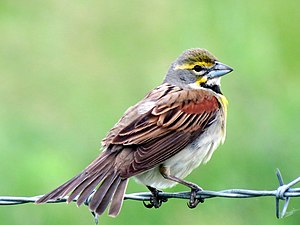Dickzissel
| Dickzissel | ||||||||||||
|---|---|---|---|---|---|---|---|---|---|---|---|---|

Dickzissel ( Spiza americana ) |
||||||||||||
| Systematics | ||||||||||||
|
||||||||||||
| Scientific name of the genus | ||||||||||||
| Spiza | ||||||||||||
| Bonaparte , 1824 | ||||||||||||
| Scientific name of the species | ||||||||||||
| Spiza americana | ||||||||||||
| ( Gmelin , 1789) |
The Dickzissel ( Spiza americana ) is an American songbird from the cardinals family. The species is the only representative of the genus Spiza .
features
The 15 cm long chisel has a yellow stripe above the eyes, a gray-brown top with black stripes on the back, dark wings, a rust-colored spot on the shoulder and a light underside. The male has a black throat spot, yellow chest, and gray hood and gray cheeks. The female and fledglings have brown cheeks and bonnets and striped flanks.
The call of the bird, a "thick-ciss-ciss-ciss", gave it its name.
Occurrence and existence
The bird breeds in open landscapes in southeast Canada and the eastern United States and migrates in larger flocks to southern Mexico, Central America and northern South America to overwinter.
The Dickzissel is one of the most common bird species in the prairie region, but the populations have declined by an annual average of 1.4 percent between 1966 and 2000. The reason for this population decline is the loss of habitat , the increasing conversion of prairies into agricultural landscape and persecution in the wintering area, where the Dickzissel is considered a crop pest. Dickzissel are also exposed to strong brood parasitism from the brown-headed cowbird . In the Great Plains , depending on the region, between 30 and 90 percent of the Dickzissel clutches also contain eggs of the brown-headed cowbird. While a young bird of the brown cowbird does not usually have a fatal effect on the young birds of the Dickzissels growing in the same nest, in regions with a high density of cowbird, more than one female of this brood parasite regularly adds an egg to the clutch.
behavior
The Dickzissel looks for insects and seeds on the ground or in fields. Outside of the breeding season, the bird searches for food in groups. In some regions, the Dickzissel is considered a pest by the farmers , as large quantities of grain are destroyed by the flocks of birds.
Reproduction
The female builds a large shell nest from plant material in bushes or in thick grass. The average of four eggs are incubated for around two weeks. The young birds fledge after about ten days. The male can mate with more than one female.
literature
- Colin Harrison & Alan Greensmith: Birds. Dorling Kindersley Limited, London 1993, 2000, ISBN 3-831-00785-3
- Bryan Richard: Birds. Parragon, Bath, ISBN 1-405-45506-3
Web links
- Videos, photos and sound recordings of Spiza americana in the Internet Bird Collection
- Spiza americana in the endangered Red List species the IUCN 2008. Posted by: BirdLife International, 2008. Accessed on December 22 of 2008.
Single receipts
- ^ Paul A. Johnsgard: Great Wildlife of the Great Plains . University Press of Kansas, 2003, ISBN 0-7006-1224-6 , p. 22
- ^ Paul A. Johnsgard: Great Wildlife of the Great Plains . University Press of Kansas, 2003, ISBN 0-7006-1224-6 , p. 23
